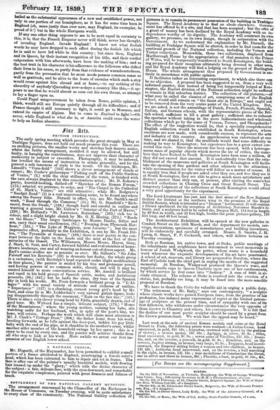lint Arts.
BRITISH INSTITUTION.
The early spring meeting which precedes the great struggle in May at Trafalgar Square, does not hold out much promise this year. There are no striking pictures, the smaller works and sketches best deserve notice, whilst the faulty arrangement, modified it may be allowed, but still faulty, in hanging the contributions, does not improve their character of mediocrity in subject or execution. Photography, it may be inferred, has levelled the means of instruction to artists generally, and for the present a safe tameness of style is the result. Of the landscapes, Mr. Liruiell's " Corn-field " (163) shows a clever arrangement of clouds at sunset ; Mr. Cooke's picturesque "Fishing craft off the Public Gardens of Venice," (3,) with the clear stillness of the water' is finished with the care always displayed by this conscientious artist; Mr. D. Roberts's poetic, hurried-looking, dashed-off "Sketches of the Roman Forum," (1734 adapted, we presume, to order, and "The Chapel in the Cathedral of St. Mark's Venice," are still attractive; while Mr. Redgmve's "Sandpit Road" (2) is a real unpretending scene, to be found anywhere among the Surrey hills. N'atoral in effect, too, are Mr. Smith's small work, "Road through the Common," (51,) Mr. G. Stanfield's "Rich- mond, from the Swale," (138,) though hard and careful in outline and wanting a general tone, Mr. Callow's "Interior of the Port of Havre," (239,) Mr. Holland's "It. Lawrence, Rotterdam," (262,) rich too in colour, and a slight bright sketch by Mr. G. E. Hering, (275,) "Reeds on the Shore." The larger landscapes by Messrs. Denby, father and
non, us
carry their usual excellencies, (81,) "Evening from Plymouth Har- bour,' (334) "The Lake of Maggiore, near Locamo " - but the most impressive effect, probably in the FYItibition, is one by kr. Frank Dil- lon "The Pyramids at Sunrise," (489,) there is real poetry in the con- trast between the light on the heads and the mist at the feet of these miracles of the Desert. The Williamses, Messrs. Moore, Hayes, Gray, J. Stark, G. Sant, and Carter, forward faithful and real snatches of home- drawn landscape, one and all wearing an honest out-of-doors aspect. Mr. Earl's canine studies are as genuine as ever. Mr. Gilbert's "Sir John Falstaff and his Recruits" (66) is dramatic but flashy, the whole group is a caricature, (with Bardolph's head repeated under slight modifications in four places,) the painter is misled by his free and grotesque pencil, and having powers of no common order, should, and will it may be, control himself to more conscientious service. Mr. Ansdell is brilliant and rapid in his bold groups of Spanish cattle, mules, and Andalusian peasants, (50,) (347,) but he lacks the clear' dry tone of the Spanish sky in both his works. Mr. Frost forwards a brilliant group in " " with his usual variety of attitude and richness of outline. " Expectancy " (157) is a charming, earnest young girl's head by Mr. Sant, and close by is Mr. Ledderdale's very natural girlish figure, look- ing disappointedly through the casement, Rain on the fair day, (161.) There is also a very clever young head by Eddie, gracefully drawn, and of good tone. Mr. Wyburd has a simple, delicate subject, (179,) "Home of the Mountaineer,' where the young mother, nursing her babe, sits watching sadly for her husband, who in spite of the poet's line, we hope, will return. Perhaps the work which will claim most attention is Mr. J. Clark's "Cottage Door," (3980 the father home from his work, bending forwards as he lolls against the door-post, tickles his gay little baby with the end of his pipe, as it chuckles in the mother's arms, whilst another older member of the household swings by her apron ; this is a story- to be read by every one, and the painter will achieve thanks from all who stop to look at his work. Here awhile we arrest our first im- pression of our English lower school.


































 Previous page
Previous page